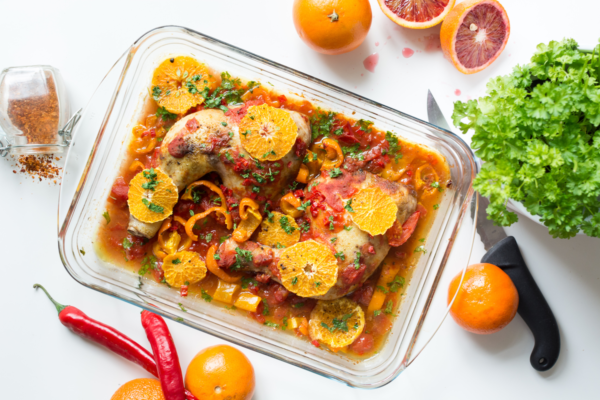 “To eat is a necessity, but to eat intelligently is an art.”
“To eat is a necessity, but to eat intelligently is an art.”
No doubt you or someone you know has adopted the LCHF (low carb, high fat) way of eating that has become trendy in recent years. From the Food Network[1] to the Mayo Clinic[2], everyone is talking about how to include healthy fats in your diet, as the research that says fat is necessary for our bodies has finally made it into the mainstream.
This is great because without consuming enough fat from food, our bodies won’t get the building blocks we need to function properly. In addition to burning fat for energy, your body needs fat to[3]:
- Create new cells. (This is why you are waterproof! Fat molecules surround each cell to prevent you from becoming like a sponge.)
- Keep your brain functioning, as nearly 60% of the brain is made of fat.
- Absorb, carry and store the fat-soluble vitamins A, D, E and K.
- Insulate your body to regulate your temperature, protect your organs, and ensure messages make it from your brain to their intended targets all over your body.
- Transmit messages between cells (even messages that originate outside of the brain).
That’s a bunch of important tasks that fat needs to perform, so it’s a wonderful thing that people are no longer afraid of eating it! (As a side note, you can consume healthy fats in lots of forms including meat and dairy from grass-fed land animals, fatty fish like salmon and mackerel, free range poultry and eggs, and unspoiled plant fats like oils, seeds and nuts. Unhealthy fats come from grain-fed land animals, caged poultry, spoiled or highly processed plant fats, and trans fats… which should be avoided like the plague!)
But, here’s the not so great thing… in the process of realizing that fat is good for us, we’ve collectively decided that carbs are now the enemy. Believe me, I know that we don’t need nearly as many carbohydrates as we generally consume. I, too, want to shout from the rooftops that cereal for breakfast, a sandwich for lunch and pasta for dinner is overkill in the carbs department. And I’m very aware that the body is quite capable of using fat for energy if necessary (even though carbohydrates are the easiest fuel source).
However, the problem with taking an “either/or” approach to these vital macronutrients is that we may miss out on the good and essential things carbohydrates do for us. You see, carbohydrates are the building blocks of plants. In fact, the primary macronutrient in most plant foods, including vegetables, fruits and legumes, is carbohydrate[4]. And wrapped up with whole-food, plant-based carbs are a multitude of vitamins, minerals, phytonutrients and fiber that our bodies need for peak performance.
In addition to this, glucose, the monosaccharide which makes up most carbohydrates and is used preferentially by the human body, is needed for:
- The duplication of our genetic material every time our cells divide[5] and
- The conversion of NADP+ to NADPH, which is an important component of antioxidant activity and the creation of fatty acids and sterols[6].
Of course, if we aren’t getting enough glucose by eating carbohydrates, the body can create it in order to handle these critical tasks. However, that will still leave us deficient in all the other nutrients and fiber that come packaged almost exclusively with plant-based carbohydrates.
So, maybe, given the importance to our health of both fat and carbohydrates, we could take a “both/and” rather than an “either/or” approach?
Don’t worry, this won’t require a massive shift in your food choices, if you follow a paleo or LCHF way of eating. Getting your carbs from lots of colorful vegetables, fruits and legumes (with the occasional slice of whole grain bread, serving of wild rice or baked potato with the skin on, if you want it) will ensure your body has the glucose it needs to function optimally without the problems that can be caused by too much of it. Plus, you’ll be consuming all of the protective nutrients found in plant foods.
In the process of shifting to a more inclusive approach to the macronutrients, we just might find that we can get all of the goodness that both fat and carbs have to offer when in the right forms and the right amounts, without any of the downsides that “too much of a good thing” can cause.
Sources:
[1] Keri-Ann Jennings. Importance of Healthy Fats.
[2] Mayo Clinic. Nutrition and healthy eating: Recommendations for fat intake.
[3] Stephanie Dunne. Nutrition Basics: Eating Fat Does NOT Make You Fat
[4] Stephanie Dunne. Nutrition Basics: Really Understanding Carbohydrates.
[5] S. Department of Health & Human Services. G6PD.
[6] Mariya Negrinova Negreva, Atanas Penev Penev, Svetoslav Jivkov Georgiev and Albena Alexandrova Alexandrova. Changes in Glucose-6-phosphate Dehydrogenase Activity in Paroxysmal Atrial Fibrillation.
Image via Foodiesfeed.com | This post may contain affiliate links, which means if you click and then purchase we will receive a small commission (at no additional cost to you). Thank you for reading & supporting Happy Living!

